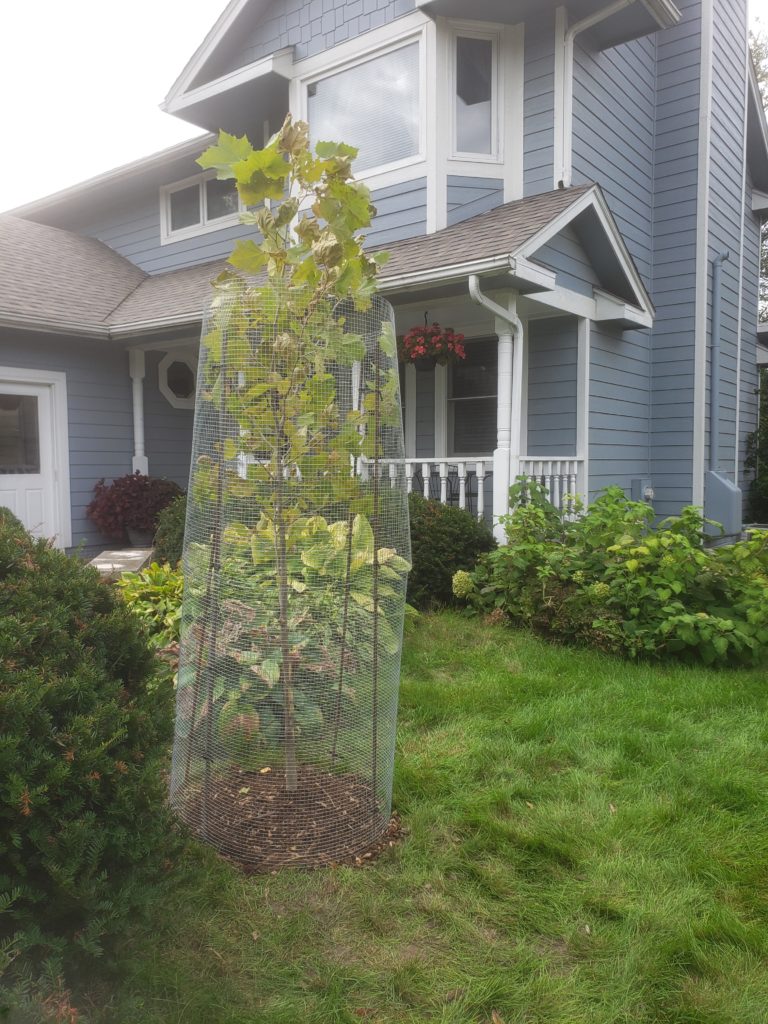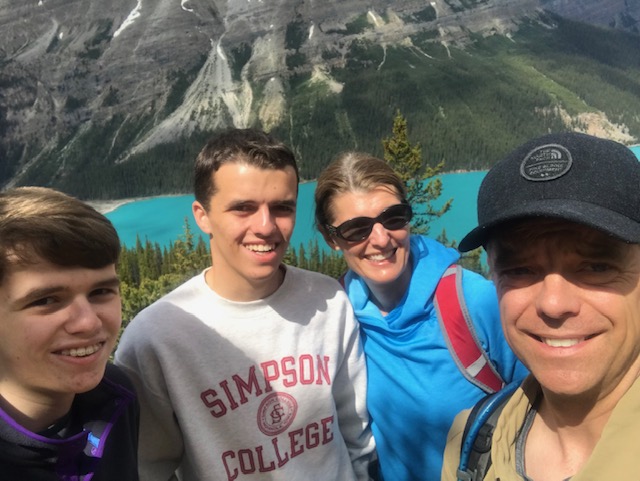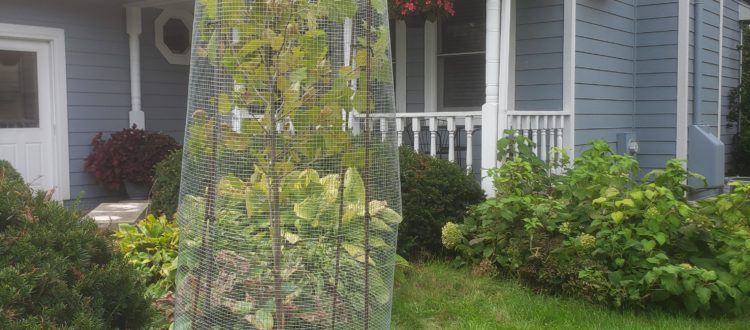Family Roots

On a typical urban property in Urbandale, Darrel Mullins strategically manages his piece of Iowa’s forest. Through his backyard window, a diverse kaleidoscope of native woody plants provide multiple benefits: shade, privacy, habitat for songbirds, and acorns for squirrels. The trees also compliment the raised garden beds of native perennials.
“If you can’t be in nature for a profession, it’s at least nice to look at it,” he said.
When Darrel moved into the home in 2004, there were a variety of trees: ash, maple, river birch, crab apple, and a single Kentucky coffee tree were scattered throughout the urban yard. Darrel often works from home so the trees provide some health benefits and inspire contemplation. The trees also bring his family together and remind him of his roots.
TINY INSECT, BIG IMPACT
When three of the trees died in short succession, Darrel knew something needed to be done. The largest tree left in the yard was the next most likely tree to be lost.
“The reason we called Luke at Prudenterra was to treat our backyard ash tree,” said Darrel.
This isn’t a new story in American urban and suburban stories. The invasive and competitive beetle, emerald ash borer (Agrilus planipennis), or EAB for short, has aggressively devastated ash trees from the east coast to the Rockies. Though adults are only about the size of a dime, EAB have taken down tens of millions of trees many thousands of times its size. Unfortunately, this time it was making its home in Darrel’s tree.

Luke came to Darrel’s home to inspect the ash tree before making a determination of its quality and therefore suitability for treatment. The bark was deeply fissured and the crown was full of actively growing green leaves – both signs of a healthy and vigorously growing tree. The form of the tree also indicated good potential for longevity with minimal branch deformities in need of correction.
“The only challenge with the ash tree was its placement,” said Luke. “The previous owner had planted it a little too close to the house and didn’t prune the lateral branches.”
The ash tree was determined a good candidate for treatment to keep it protected from EAB. For valuable ash trees, owners can elect to have a professional inject the trees with a special, restricted-use insecticide. TREE-äge® is restricted to forester professionals and its active ingredient is emamectin benzoate. When injected with the proper concentration, the insecticide will kill any insect that feeds on the living tissues of the tree without killing the tree or beneficial wildlife. Judicious pesticide use is a standard tool used in forest management plans for various benefits after other, non-chemical, options have been considered. Treatments can range from protecting a single tree from an insect pest or a whole area of forest, like the case of gypsy moth with helicopter applications.
“Unlike other insecticides on the market, which require annual treatments, TREE-äge® is only needs to be applied every two or three years,” said Luke. “The inner-bark tissues the EAB eat are filled with nutritious sap critical to the successful life of the tree; We do everything we can to protect that.”
Signs of EAB can be difficult to find. Some examples of potential signs are:
- Thinning or dying leaves at the crown of the ash tree
- Sucker circles at the base
- Very small D-shaped exit holes
- Splitting bark with extensively snaking tunnels on the underside
- Increase in woodpecker activity
If you think your ash tree has EAB, report your concern to the USDA Emerald Ash Borer Hotline at 1-(866) 322-4512. Connect with us if you are unsure about the health of your trees or if you’re interested in learning about treatment options.
MORE HOPE
With all natural systems, death gives room for new life. The Prudenterra operations team got to work by planting two new species of trees nearby, a bur oak and a sugar maple. This establishes the two new trees to keep the remaining shade in the yard in case the ash tree needs removed in the future.
After a couple years of growth on the site, the sugar maple needed some care. Unlike the bur oak, which has thick bark to protect the nutritious sap from browsing wildlife, the sugar maple needs protection from animal damage. With a damaged sleeve from heavy snowfall, the backyard maple was a crowd favorite with the local wildlife and was struggling to survive as a wildlife buffet.
“It seemed like the deer loved the maple more than we did,” said Darrel. “But Luke has given that little thing more hope.”
In the winter of 2019, wildlife chewed and rubbed on the smooth bark of the tree, or “girdled” the trunk. This caused the shoots above the damaged bark to die then resprout new shoots from the ground. Now properly sheltered, the tree should make a full recovery in about three years.

WHITE SLEEVES FROM SPACE
The front yard river birch tree had been declining for many years due to old age and incompatibility of site location. It was replaced with an Ohio buckeye tree.
“Luke installed the buckeye tree with a protective sleeve, about five feet tall and very white. It’s so white if you Googled our house, you could see that white post; you could see it from space!” said Darrel. “But the sleeve did its job and kept the tree alive.”
All of the new trees are relatively young, about five years old. Though they are young, they are thriving, growing in great form with healthy vigor and in the proper locations. The new trees fit Darrel’s objectives, the trees’ needs, and the yard’s topography. They are young enough to be more hope than they are tree, but there is still a lot of promise in the urban reforestation project.
PAST TO PRESENT
As an Ohio native, Darrel grew up surrounded by trees, notably the buckeye tree. It’s been lore in Ohio since the 1800s that a squirrel could cross the state without ever touching the ground because of the high density of trees.
As Darrel grew up he liked trees, as most kids do. Fortunately, the house he lived in had a lot of trees. Two of the trees were planted by the young boys that lived in the home before Darrel’s family. The two previous boys got the trees in a school project. As he and his brother grew up, they used the trees for fun as hammock posts, a zip-line and of course for climbing.
“I associate a lot of my childhood stories with the trees in the yard,” said Darrel. “So when I moved here and in fairly short order the trees began to die, it only seemed natural to assume the role of reforesting the yard.”
The Ohio buckeye replaced the river birch and serves as a reminder of Darrel’s childhood home. Since trees hold special memories for Darrel’s family, the river birch was replaced with the highest quality nursery stock possible.

“I like all the trees, but the buckeye tree has created the greatest source of family humor,” Darrel said. “I was ridiculed for stoutly defending this little twig – back when it was still a twig. It even started a family interest in making buckeye candies.”
Occasionally, Prudenterra has recommendations that seem counter-intuitive, like planting smaller trees. In this case, the younger, smaller, trees have a larger “root to shoot” ratio, which means there’s more plant below-ground than above-ground. The better “root to shoot” ratio enables the trees to grow vigorously and actually outpace larger trees in the same age bracket within a few years.
REFORESTATION IS IN THE FAMILY
Being an Iowa transplant, Darrel had a lot of hope for his yard. Using his cheerful childhood memories as a launching point, he aimed to increase the amount of shade in the front yard and add a colorful fall canopy over a winding path. The plan not only fit the house and property topography, but the restoration also brought back youthful memories.
Darrel’s new trees were selected, in part, as representatives of decades of sentimental family significance. In addition to the nostalgic Ohio buckeye, Prudenterra planted an American sycamore in the front yard. This tree grows quickly and will increase shade in the front yard. Moreover, Darrel’s father graduated from Indiana State University so the sycamore is a reminder of his father’s home team mascot. Yet, Darrel’s father didn’t begin the family tradition of taking interest in trees.

“My grandfather on my mother’s side was a railroad engineer,” recalled Darrel. “Like most burly railroad engineers of his time, he was passionate about ornamental flowers,” he chuckled fondly.
What Darrel’s grandfather had an eye for was not just beautiful bouquets of eye-catching ornamentals. His grandfather knew how one plant would look different over the course of the year. With that knowledge, his grandfather gave extra thought into how to best utilize the seasonal colors. To get the most striking fall colors, he would go out into the forest to tie yarn around the saplings he might want to replant.
“He would paint with time since he knew how it would look over the course of the season,” said Darrel. “If I were good at it I would pick things that would sequentially pop but I’m not that good; fortunately, Luke is. Luke was able to guide us through what is native to the area, what is likely a good tree for the yard, and what it will do over time.”

“As a forester, I help leave my client’s land in a greater state of native plant diversity and forest health than when I found it.” Luke said. “It’s a privilege to understand a landowner’s values. I always bring that into alignment with their land management strategy. That is one of the most important components to have a sustainable relationship with our nearby nature.”
Resources
Timber management: https://www.prudenterra.com/forestry/planning-consulting/#timbersales
Urban forestry (plantings, plans, inventory, and injections): https://www.prudenterra.com/forestry/urban-forestry/

